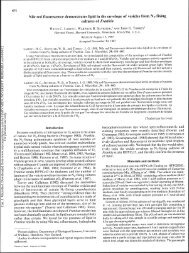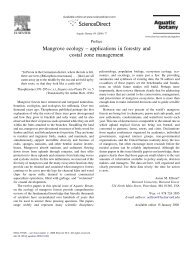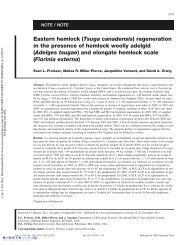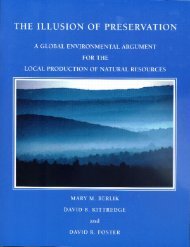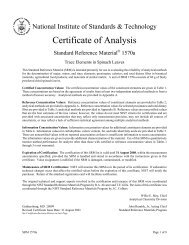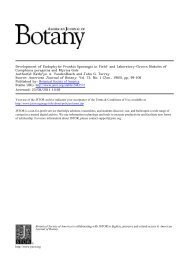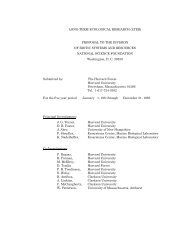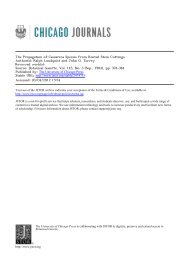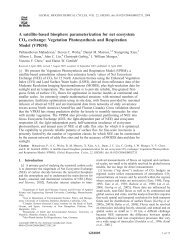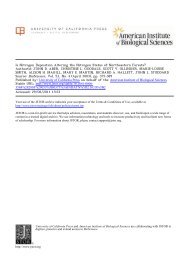Abstracts of Papers - Harvard Forest - Harvard University
Abstracts of Papers - Harvard Forest - Harvard University
Abstracts of Papers - Harvard Forest - Harvard University
Create successful ePaper yourself
Turn your PDF publications into a flip-book with our unique Google optimized e-Paper software.
plant communities that has been extensively<br />
employed throughout Europe. Basic principles<br />
by which different hierarchial groups <strong>of</strong><br />
lichens are distinguished, are discussed and<br />
examples are given. Epiphytic lichen associ-<br />
ations have clearly been modified over the<br />
past two hundred years. This can be docu-<br />
mented by herbarium records as well as carto-<br />
graphic studies. Even the formerly widely<br />
distributed Xanthorion parietinae alliance,<br />
that normally prospers in areas adjacent hu-<br />
man settlements, has declined markedly. Many<br />
<strong>of</strong> the patterns in lichen community modifica-<br />
tions can be correlated with measured SO2<br />
levels. A number <strong>of</strong> lichen species have ap-<br />
parently disappeared entirely from the Feder-<br />
al Republic <strong>of</strong> Germany and about 50% <strong>of</strong> the<br />
lichen flora is considered endangered.<br />
Poster Session<br />
BASILE, DOMINICK V., MARGARET R. BASILE<br />
and ROSS E. KONING. Lehman College <strong>of</strong><br />
CUNY, Bronx, N.Y. 10468 and Rutgers Univ.<br />
Piscataway, N.J. 08854.<br />
- Ethylene production and its possible<br />
role in regulating leaf and branch devel-<br />
opment in Plagiochila arctica, a leafy<br />
liverwort.<br />
Ethylene production by gametophytes <strong>of</strong><br />
Plagiochila arctica Bryhn & Kaal. in axenic<br />
culture was determined by means <strong>of</strong> gas-<br />
liquid chromatography (GLC). Exogenous<br />
indole acetic acid (IAA) at approx. 6x<br />
10-5M markedly stimulated ethylene syn-<br />
thesis while aminoethoxyvinyl glycine (AVG)<br />
at approx. 10-5M significantly suppressed<br />
it. In these respects ethylene production<br />
and its regulation are the same in P.<br />
arctica as in representatives <strong>of</strong> the<br />
flowering plants (Magnoliophyta). Although<br />
these results may have been inferred, they<br />
were hitherto unsubstantiated. Furthermore,<br />
these data in conjunction with those ob-<br />
tained in previously completed experiments<br />
lend support to an hypothesis that auxin-<br />
induced ethylene synthesis plays an impor-<br />
tant role in regulating leaf and branch<br />
development in leafy liverworts, particu-<br />
larly those originating from ventral mero-<br />
phytes.<br />
JANSSENS, JAN A. & PAUL H. GLASER. Limnological<br />
Research Center, <strong>University</strong> <strong>of</strong> Minnesota, Minneapolis,<br />
MN 55455.<br />
- Fossil bryophytes and peat stratigraphy in the<br />
development <strong>of</strong> Red Lake Peatland, northern Minnesota.<br />
Ten peat cores, reaching down to the mineral sediment,<br />
taken along a transect 7-km long in the center<br />
<strong>of</strong> the vast Red Lake Peatland in northern Minnesota,<br />
were analyzed to reconstruct the development <strong>of</strong> a<br />
mire complex consisting <strong>of</strong> forested ovoid bog islands<br />
separated by internal water tracks marked by patterned<br />
fens. The reconstruction <strong>of</strong> past bog, poor-fen,<br />
and rich-fen communities is based primarily on the<br />
quantitative analysis <strong>of</strong> fossil bryophyte assemblag-<br />
Bryological and Lichenological Section 3<br />
es; concentration by weight and volume, accumulation<br />
rates, and percentages <strong>of</strong> identified taxa were cal-<br />
culated. The sharply defined bryophyte zones were<br />
stratigraphically correlated among cores by radio-<br />
carbon dates, the regional pollen zonation, and bu-<br />
ried wood layers. Peat-accumulation rates, calculated<br />
from radiocarbon dates, were correlated with measure-<br />
ments <strong>of</strong> bulk density, humification, and peat ontoge-<br />
ny as based on the local paleoenvironmental recon-<br />
struction. The peat stratigraphy indicates that bog<br />
vegetation originated about 5000 years ago at the<br />
watershed crest and then extended downslope, growing<br />
over rich-fen peat in the process. Cores from the<br />
internal water tracks contain a striking sequence in<br />
fossil assemblages, changing from a basal rich-fen<br />
zone to a bog or oligotrophic poor-fen zone and then<br />
reverting back to a rich-fen zone towards the top.<br />
This stratigraphy supports an earlier hypothesis,<br />
based on the study <strong>of</strong> present-day landforms, that the<br />
internal water tracks originated recently within a<br />
continuous complex <strong>of</strong> forested raised bogs, with<br />
poor-fen lawn flanks. Conversion <strong>of</strong> the bog into<br />
ovoid islands resulted in the complex landscape.<br />
Contributed <strong>Papers</strong><br />
Allen, Bruce H. Department <strong>of</strong> Biological<br />
Sciences, <strong>University</strong> <strong>of</strong> Cincinnati,<br />
Cincinnati, Oh 45221.- The protonema <strong>of</strong><br />
Drummondia prorepens.<br />
Spore germination in D. prorepens is<br />
precocious and endosporic. On sowing <strong>of</strong><br />
these endosporic protonemata dimorphic<br />
protonemal filaments arise: those with long<br />
rhomboidal cells having end walls oblique<br />
to the long axis, and those with cells more<br />
or less square the end walls at right angles<br />
to the long axia. By means <strong>of</strong> anticlinal<br />
and periclinal divisions in the latter a<br />
massive three-dimensional protonema is<br />
formed.. Periclinal divisions in the former<br />
results in their elongation into the medium.<br />
Occasional divisions at right angles to the<br />
oblique end walls <strong>of</strong> the long celled fila-<br />
ments form cells that give rise to three-<br />
dimensional cell masses. Leafy gametophytes<br />
originate on the primary cell mass within<br />
20 days, and on the secondary cell masses<br />
within 59 days. This sporeling type is<br />
similar to that reported for some species<br />
<strong>of</strong> Ptychomitrium, Hedia and Drummondia.<br />
The sa.lient feature <strong>of</strong> this type is the<br />
ability to form, free from the constraint<br />
<strong>of</strong> the spore wall, a primary three- dimen-<br />
sional protonema. Rapid development <strong>of</strong><br />
leafy gametophytes is considered the<br />
principal advantage <strong>of</strong> this type <strong>of</strong> spore-<br />
ling development: minimizing the risk <strong>of</strong><br />
dessication and <strong>of</strong> being washed onto an<br />
unsuitable substrate.<br />
ANDERSON, DAVID C., LARRY<br />
ST. CLAIR 360 Wakara Way<br />
Salt Lake City, Utah 84108<br />
-Selection <strong>of</strong> useful parameters in assessing lichens<br />
as biological monitors <strong>of</strong> air pollution.<br />
The use <strong>of</strong> lichens as biological monitors <strong>of</strong> air qual-<br />
ity although in its infancy affords an "early warning"




